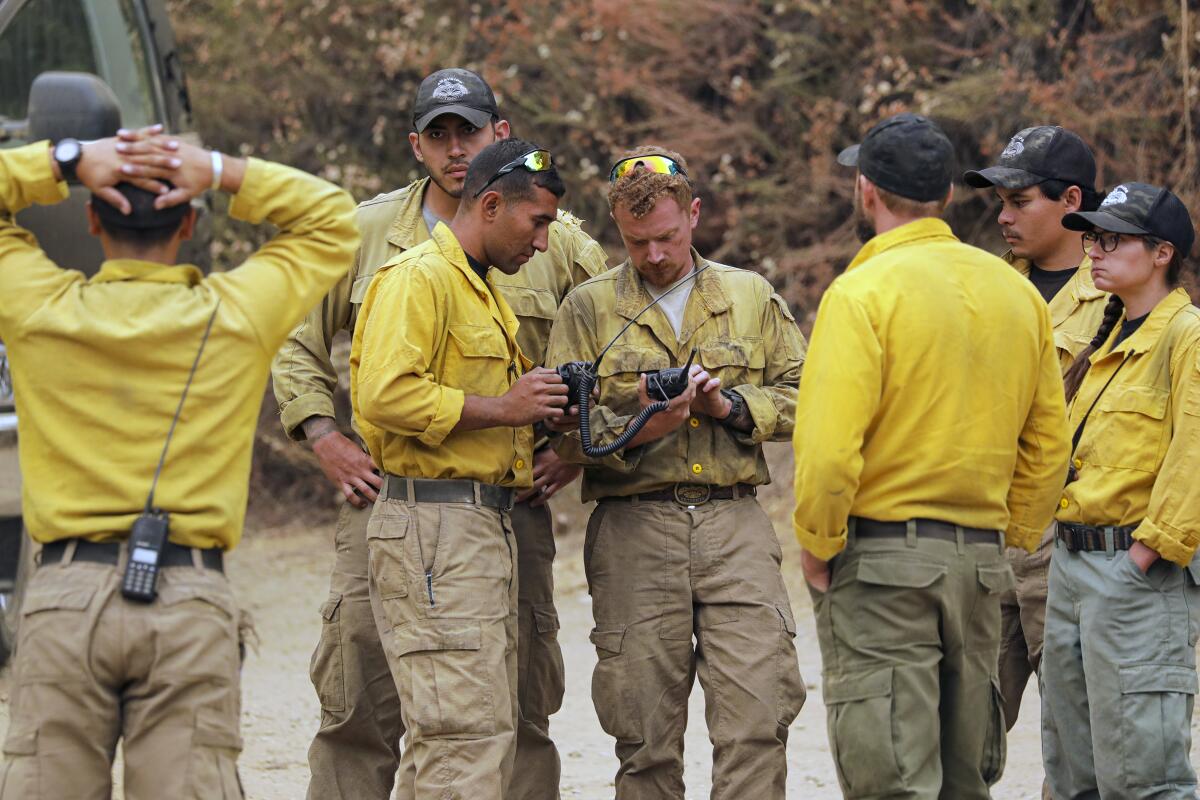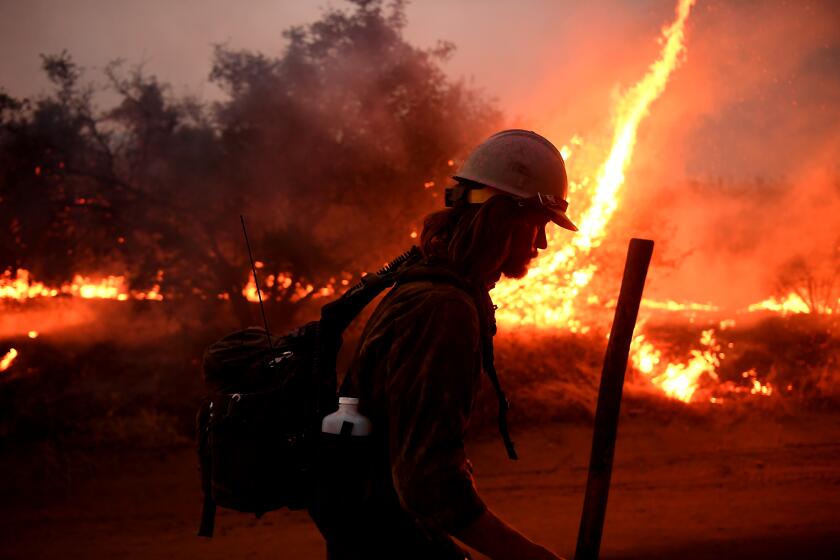Bobcat fire keeps growing, and winds could push it into Monrovia, Arcadia and other foothill communities

- Share via
The Bobcat fire continued to burn unchecked Tuesday through the Angeles National Forest and officials warned that Santa Ana winds could cause the fire to threaten homes in several foothill communities.
At 0% containment, the fire has burned more than 10,000 acres as of Tuesday night with red flag warnings issued due to the windy conditions.
“The big worry is the weather model, which is forecasting a shift in the winds to Santa Ana winds,” said Angeles National Forest representative John Clearwater, “and there is a possibility of that fire being pushed south. South of the fire line is our foothill communities.”
Residents of Monrovia, located at the base of the forest, have already been placed on notice and are being urged to stay alert for official evacuation orders. If an order is issued, the city said it would work in two phases, Phase 1 to include residents north of Hillcrest Boulevard north of Greystone Avenue, and Phase 2 to include residents between Hillcrest Foothill boulevards.
“We have been told to plan for the fire to get worse and we are asking all residents to be prepared and ready if an evacuation order is issued,” the city said in a statement. “Santa Ana winds can change the fire conditions incredibly quickly.”
Arcadia also said residents living Foothill Boulevard and east of Santa Anita Avenue should be prepared to evacuate.
The nearby cities of Duarte and Sierra Madre are also urging residents to remain vigilant.
Residents of Monrovia were on edge as fire trucks roamed the neighborhood.
Cliff Armstrong, a cable marketer, has lived in the Cloverleaf Canyon neighborhood for 21 years. He said Tuesday that he has never seen so many firefighters moving in and around the area before.
Earlier in the day, Armstrong was watching helicopters dip large buckets into a sawpit debris basin. He saw firetrucks traveling up and down the street for the last two days.
“I’ve never seen this level of preparation before,” he said.
Residents such as Armstrong say if they’re forced to evacuate it would be the first time they will have to flee their homes. Fires have come and gone through this area, including the Station fire in 2009.
Armstrong said he stayed behind, watering his home during that blaze.
“I don’t think I’ll risk it this time,” he said.
Neighbors have started packing up their cars and moving vehicles to the homes of friends living away from the mountains or in other cities. They share tips with one another about how to best defend their homes from a fire.
Outside their homes, Armstrong and his neighbor talk about those efforts. His neighbor tells him he’s removed all the cushions around the patio and floor mats, anything that is combustible.
“Oh, right, right. Well, wait a minute,” Armstrong said. “I have a garage full of toilet paper and paper towels because of the COVID thing, man,”
He chuckled.
“Remember it was hard to find? So I have a bunch of paper goods sitting in the garage.”
The National Weather Service has issued a red flag warning through 8 p.m. Tuesday for the mountains and valleys of Ventura and Los Angeles counties.
Intense Diablo winds are forecast for parts of Northern California while Santa Ana winds are expected in Southern California.
The Bobcat fire started just after noon Sunday, and is one of two fires currently burning in the region. The El Dorado fire in the San Bernardino National Forest has burned more than 10,000 acres and is roughly 16% contained.
The Bobcat fire’s “remote and rugged location” has made it challenging to contain, Clearwater said, adding that establishing and reinforcing bulldozer lines around the fire is a top priority. The Forest Service is now estimating its containment date as Oct. 15.
“It is growing rapidly,” Clearwater said. “A lot of thought and preparation is going into how to mitigate and prevent that fire from moving into a position where it poses a serious risk.”
Record heat. Raging fires. What are the solutions?
Get Boiling Point, our newsletter about climate change, the environment and building a more sustainable California.
You may occasionally receive promotional content from the Los Angeles Times.
The Mt. Wilson Observatory has a half-million-gallon, gravity-fed water tank filled and ready for battle should the Bobcat fire close in on the property, said the observatory’s director Tom Meneghini.
Three employees remain at the mountaintop location as a skeleton staff, ready to hand over the keys and fire hoses to firefighters if needed, Meneghini said.
The Bobcat fire is the third in as many months to pose a danger to the observatory, but the gravest threat in recent memory was the 2009 Station fire.
“That took the cake,” Meneghini said. “We had Arizona hotshots camped up there in the dome, living up there. They were fighting defensively from the observatory. We hope this isn’t a repeat.”
Conditions were calm Tuesday morning, as seen on observatory surveillance cameras, Meneghini said. But Santa Ana winds forecast for the days ahead have him concerned.
“I don’t know what that’s going to do, that’s the wild card in this whole thing,” he said. Fire risk is part of forest life — “like gravity, there all the time,” Meneghni said, He welcomed federal authorities’ decision to close national forests in California during the current heat wave.
“Given the heightened danger, I think it’s good. I’m just kind of jaundiced on my fellow men being responsible for these conditions,” Meneghini said of the fires. “Privilege comes with responsibility ... and we are our own worst enemies.”
More to Read
Sign up for Essential California
The most important California stories and recommendations in your inbox every morning.
You may occasionally receive promotional content from the Los Angeles Times.
















